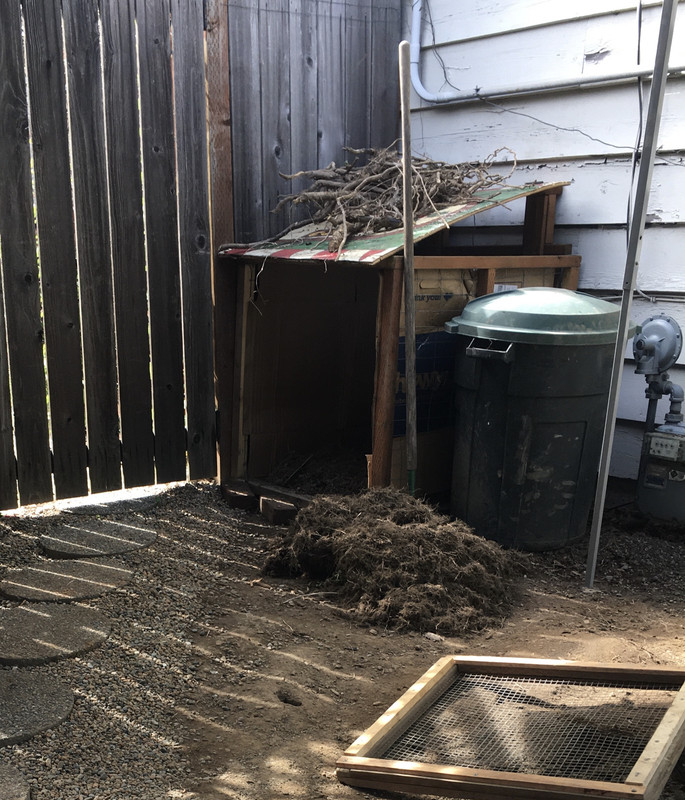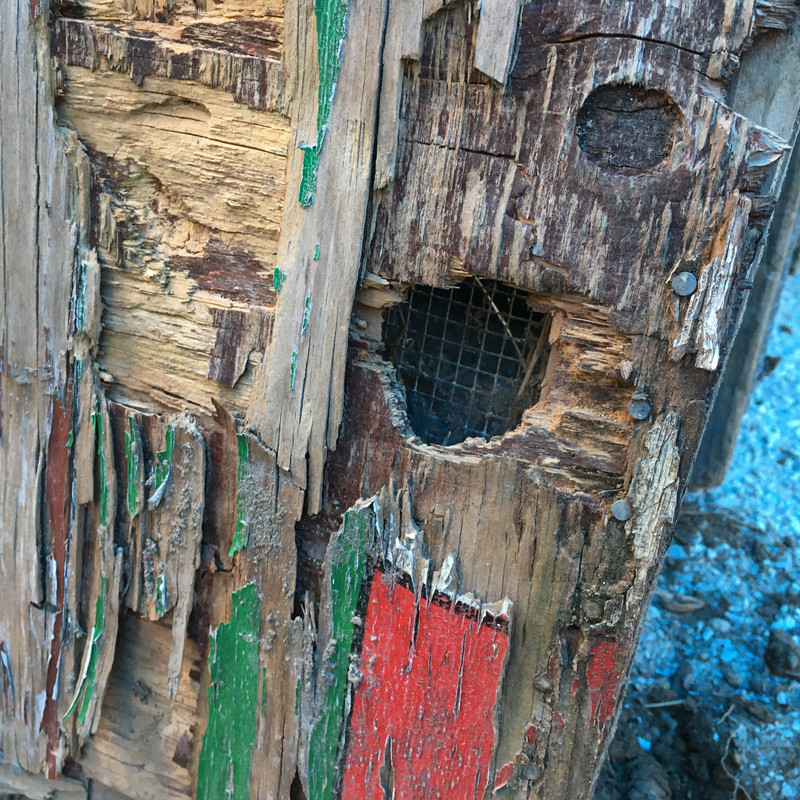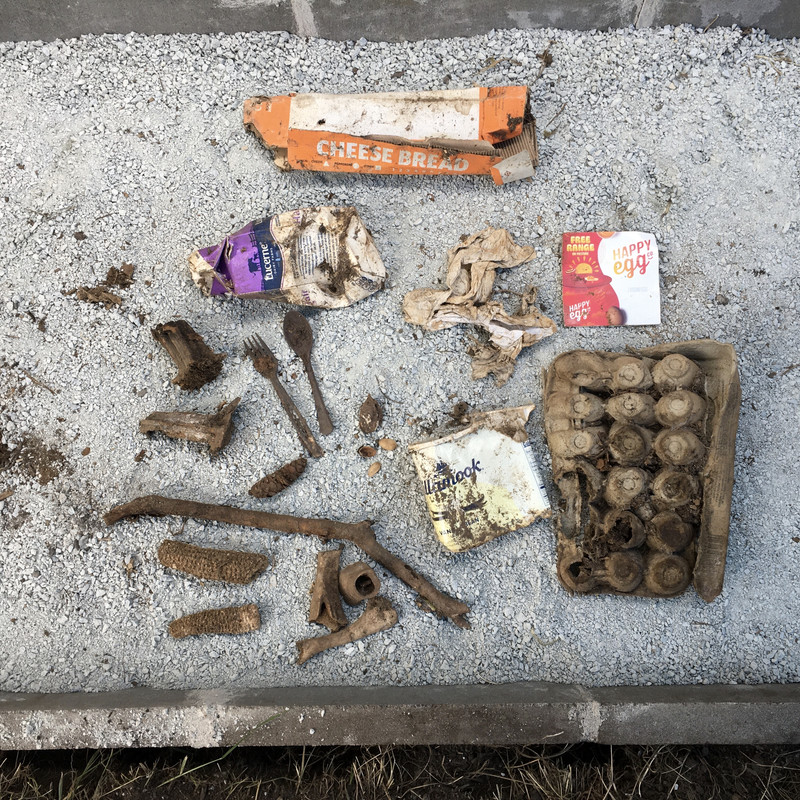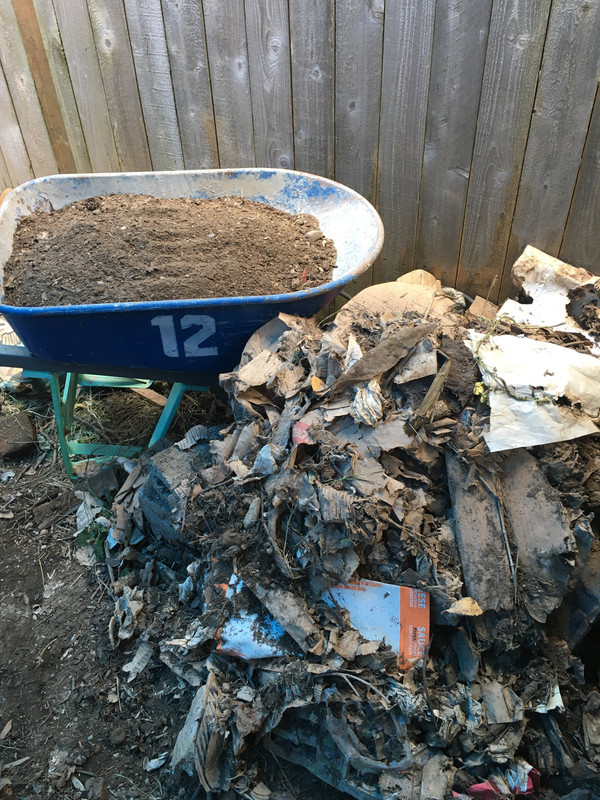Gardening
Related: About this forumThings found in my compost bin after 3 years
I fully expect a lot of “Well, duh!” responses - just thought it would be an interesting thread for newbie gardeners such as myself.
So, back in 2020 when bottled water and tp were scarce, I decided to learn a bit about gardening. Even bought a few books including one on composting… but I guess some things you really have to learn by doing.
Since I prefer to do things the hard way if at all possible, I made my own bin. It looked kinda like this at first:

That screen in the foreground that I was using to sift dirt got screwed to the front, along with a piece of plywood.
The bin eventually started sinking towards the house with the help of some rats who burrowed under it. (That was after I put wood over the sides which had previously been cardboard behind 2”x4” wire fencing.)
I took off the front panel and turned the pile once, maybe a year after putting it into service. After that, I said “screw it.” Kept adding stuff, including food (some of it was pre-composted with Bokashi bran, but I don’t think the rats really minded.) Needless to say, it reeked. Last fall, after some nudging from my fiance, I finally tossed a bunch of dirt on top of everything and stopped adding food - I now bury the Bokashi stuff elsewhere and let the rest go into the city’s yard waste bin.
So, this spring I’m re-doing the entire side yard. Keeping the bin, but giving it a few upgrades. Here’s what it looks like now:
8” base of blocks added

Wire and wood for the sides, better roof, hopefully rat-proof…?

Now, I think I’ll put hinges on the front this time. Question is, should I leave the plywood on or take it off? There’s a screen behind it. What say ye, DU gardeners?

(I bet this was one disappointed rat…)

Oh, ok, yes, you got sucked in by my title line and you’re about to completely lose all patience with me. So again bear in mind that I didn’t toss this stuff like I was supposed to, and I’m not really sure if my bin is ideal either. Here’s a good representative sample of what I found (plus a few pizza boxes):

I had been told that egg cartons were good… not so much. “Compostable” flatware? Not within 3 years. Bones, no. Pine cones, not really. Pumpkin stems… nah. Pistachio shells nope. Corn cobs, surprisingly no. Maybe if they were cut up and tossed into a food processor? But these are all minor things, compared to the sheer volume of cardboard and paper I pulled out:

I did get a full wheelbarrow of compost-ish soil, so that’s something I guess.
Overall, I’d say if the ban on food in the bin ever gets lifted (in other words, if the apocalypse actually materializes) I’d leave out the paper and cardboard, or at least tear it up into small pieces, and put a lot more green stuff in than I did in the past.
Alpeduez21
(1,752 posts)To the collection of non composted materials
Tetrachloride
(7,855 posts)at ten thousand dollars a show
Hermit-The-Prog
(33,356 posts)WestMichRad
(1,327 posts)… will really slow decomposition.
Interesting results, thanks for the post! In addition to the items you noted that don’t break down, pits (like peach pits), walnut shells and woody materials don’t decompose very fast. Egg shells are also very slow to break down unless we crunch them into small pieces first.
I have a big compost heap that I use for lawn and garden waste, food waste (no rat problem here), and leaves. Gave up trying to fence it long ago… critters are gonna visit and snack, so be it. (Mostly raccoons, deer, an occasional possum or stray dog). I never turn it over, except… In spring when I want compost to amend the garden soil, I move the non-composted material to one side and shovel out the good compost. Typically get at least a dozen wheelbarrow loads of good rich compost each year.
We’ve been doing this for 35 years here and have really terrific garden soil! Excellent for growing tomatoes (among others), and since one certain NC Tomatoman has provided many a great recommendation for tasty varieties, I’m blessed with a delicious avalanche of yummies (coming soon)!
Hermit-The-Prog
(33,356 posts)alittlelark
(18,890 posts)And water it more often. ![]()
Shermann
(7,423 posts)You want the natural pulp / unbleached varieties as I understand it.
marble falls
(57,124 posts)... the only paper used should be unpolished, uncoated paper like news paper,paper towels.
ratchiweenie
(7,754 posts)cardboard unless you shred it first. A better use for the cardboard is to put it down in the garden paths. Lay it down and wet it and in a few weeks it melts into the ground and you have really great pathways. And everyone is correct. You need to add water and you need to turn your compost. If you don't have a hose there, just use a watering can and use a pitch fork to turn the compost at least once a season. You'll be amazed how much faster it breaks down. My sister in law collects all her kitchen peels, etc., in a blender and blends them at the end of the day and pours them in her compost blend. She has a very nice compost. Doesn't have to add water and the grass and leaves break down very quickly.
MissB
(15,810 posts)I don’t add bones. But things like paper do break down well. I add bits here and there to my Bokashi bins- things like napkins, bits of cardboard etc. I throw in avocado pits and peels too.
Here is sort of the long winded description of my process:
I have four Bokashi bins on my back porch. I have a large plastic yogurt container on my counter (or in my sink) for veggie scraps plus paper. Note that I keep the size of things to about 2”. When that gets full. I take it to the back porch and open up the available Bokashi bin and add the material, using an old potato masher to compress it. I throw in a toddler size handful of the Bokashi bran, put the piece of paper bag back on top (torn bag that fits the opening, helping to keep things anaerobic). Close bin. Once a bin is full, I move on to the next one. When I get close to having all 4 bins full, I take the oldest 2 out to my 2 active compost bins outside and add them on top of each. Then I rinse the Bokashi bins out and put the empty ones at the ends of the line.
In the summer when I have a lot of material in the yard, I tend to use two of my outside bins as hot compost bins- I’ll add a bunch of layers all at once and include a Bokashi bin in each. It takes about a month for those big compost bins to break down completely. I also have two other identical bins to throw stuff in while those two are cooking. I have chickens so I always have tons of green and browns between their litter and the yard waste. (Their poop board uses shredded paper).
Anyway, by the time the hot compost is ready, those avocado pits are crumbly. They’ve been through the Bokashi process and the hot composting process.
(I’d personally tear apart that egg carton, and for me, corn cobs go to the chickens, then into hot compost.)
I use a lot of paper- I’m not afraid to put it in either the Bokashi bin or the compost pile. As long as you’re adding greens and browns in some layers, it should easily break down.